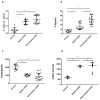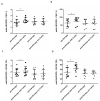Carbocysteine Modifies Circulating miR-21, IL-8, sRAGE, and fAGEs Levels in Mild Acute Exacerbated COPD Patients: A Pilot Study
- PMID: 35215330
- PMCID: PMC8880736
- DOI: 10.3390/ph15020218
Carbocysteine Modifies Circulating miR-21, IL-8, sRAGE, and fAGEs Levels in Mild Acute Exacerbated COPD Patients: A Pilot Study
Abstract
Patients with Chronic Obstructive Pulmonary Disease (COPD) periodically experience acute exacerbation (AECOPD). Carbocysteine represents a valid add on therapy in COPD by exerting antioxidant and anti-inflammatory activities. The in vivo effects of carbocysteine on inflammatory markers are not yet fully understood. The aims of this study were to assess: (i) miR-21, IL-8, soluble Receptor for Advanced Glycation End Products (sRAGE), and fluorescent Advanced Glycation End Products (fAGEs) in control subjects (n = 9), stable (n = 9), and AECOPD patients (n = 24); and (ii) whether carbocysteine modifies these markers and the functional parameters in mild AECOPD patients. Mild AECOPD patients received or not carbocysteine along with background inhalation therapy for 20 days. At the onset and at the end of the observation period, the following parameters were evaluated: FEV1, FEF25-75%, CAT questionnaire; miR-21 by Real Time PCR; IL-8 and sRAGE by ELISA; and fAGEs by spectro-fluorescence method. COPD patients showed higher levels of miR-21, IL-8, fAGEs and lower levels of sRAGE compared to that of controls. miR-21 inversely correlated with FEV1. IL-8 and fAGEs were significantly different in stable and exacerbated COPD patients. Carbocysteine improved symptoms, FEV1 and FEF25-75%, increased sRAGE, and reduced miR-21, IL-8, and fAGEs in mild AECOPD patients. The present study provides compelling evidence that carbocysteine may help to manage mild AECOPD by downregulating some parameters of systemic inflammation.
Keywords: COPD; antioxidants; carbocysteine; exacerbations; inflammation; respiratory pharmacology.
Conflict of interest statement
Elisabetta Pace’s competing interests: she received an unconditional grant by Dompè. This relationship did not influence author’s objectivity. Luigi Lanata is an employee of Dompè. This relationship did not influence authors’ objectivity. All the other authors declare that there is no conflict of interest regarding the publication of this paper.
Figures






Similar articles
-
Reduced soluble receptor for advanced glycation end-products in COPD.Eur Respir J. 2011 Mar;37(3):516-22. doi: 10.1183/09031936.00029310. Epub 2010 Jul 1. Eur Respir J. 2011. PMID: 20595148
-
The usefulness of soluble receptor for advanced glycation end-products in the identification of COPD frequent exacerbator phenotype.Int J Chron Obstruct Pulmon Dis. 2018 Nov 29;13:3879-3884. doi: 10.2147/COPD.S186170. eCollection 2018. Int J Chron Obstruct Pulmon Dis. 2018. PMID: 30568439 Free PMC article.
-
The clinical value of lncRNA MALAT1 and its targets miR-125b, miR-133, miR-146a, and miR-203 for predicting disease progression in chronic obstructive pulmonary disease patients.J Clin Lab Anal. 2020 Sep;34(9):e23410. doi: 10.1002/jcla.23410. Epub 2020 Jun 25. J Clin Lab Anal. 2020. PMID: 32583510 Free PMC article.
-
Clinical Efficacy of Carbocysteine in COPD: Beyond the Mucolytic Action.Pharmaceutics. 2022 Jun 14;14(6):1261. doi: 10.3390/pharmaceutics14061261. Pharmaceutics. 2022. PMID: 35745833 Free PMC article. Review.
-
Carbocysteine: clinical experience and new perspectives in the treatment of chronic inflammatory diseases.Expert Opin Pharmacother. 2009 Mar;10(4):693-703. doi: 10.1517/14656560902758343. Expert Opin Pharmacother. 2009. PMID: 19239402 Review.
Cited by
-
Gata3 drives miR-21-5p transcription to mitigate hyperoxia-induced lung injury, independent of CpG Island methylation.Sci Rep. 2025 Jul 4;15(1):23966. doi: 10.1038/s41598-025-09039-2. Sci Rep. 2025. PMID: 40615595 Free PMC article.
-
Oxidative Stress, Environmental Pollution, and Lifestyle as Determinants of Asthma in Children.Biology (Basel). 2023 Jan 13;12(1):133. doi: 10.3390/biology12010133. Biology (Basel). 2023. PMID: 36671825 Free PMC article. Review.
-
Non-Coding RNAs in Airway Diseases: A Brief Overview of Recent Data.Cancers (Basel). 2022 Dec 22;15(1):54. doi: 10.3390/cancers15010054. Cancers (Basel). 2022. PMID: 36612051 Free PMC article. Review.
-
Harmful Free Radicals in Aging: A Narrative Review of Their Detrimental Effects on Health.Indian J Clin Biochem. 2024 Apr;39(2):154-167. doi: 10.1007/s12291-023-01147-y. Epub 2023 Aug 1. Indian J Clin Biochem. 2024. PMID: 38577147 Free PMC article. Review.
-
Pneumonic Injury and Repair: A Synopsis.Pharmaceuticals (Basel). 2023 Sep 5;16(9):1255. doi: 10.3390/ph16091255. Pharmaceuticals (Basel). 2023. PMID: 37765063 Free PMC article.
References
-
- Singh D., Agusti A., Anzueto A., Barnes P.J., Bourbeau J., Celli B.R., Criner G.J., Frith P., Halpin D.M.G., Han M., et al. Global Strategy for the Diagnosis, Management, and Prevention of Chronic Obstructive Lung Disease: The GOLD science committee report 2019. Eur. Respir. J. 2019;53:1900164. doi: 10.1183/13993003.00164-2019. - DOI - PubMed
Grants and funding
LinkOut - more resources
Full Text Sources
Miscellaneous

